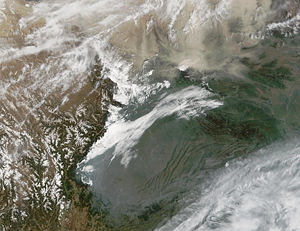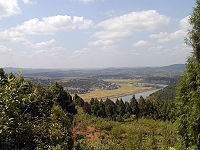
Sichuan basin
Encyclopedia

Depression (geology)
A depression in geology is a landform sunken or depressed below the surrounding area. Depressions may be formed by various mechanisms.Structural or tectonic related:...
in southwestern China
China
Chinese civilization may refer to:* China for more general discussion of the country.* Chinese culture* Greater China, the transnational community of ethnic Chinese.* History of China* Sinosphere, the area historically affected by Chinese culture...
. Despite its historical name, it is not only synonymous to Sichuan province
Sichuan
' , known formerly in the West by its postal map spellings of Szechwan or Szechuan is a province in Southwest China with its capital in Chengdu...
, comprising its central and eastern portions as well as part of Chongqing Municipality
Chongqing
Chongqing is a major city in Southwest China and one of the five national central cities of China. Administratively, it is one of the PRC's four direct-controlled municipalities , and the only such municipality in inland China.The municipality was created on 14 March 1997, succeeding the...
(which itself was, until 1997, politically part of Sichuan). Due to its relative flatness and fertile grounds, it is heavily populated with a population of more than 100 million. In addition to being a dominant geographical feature of the region, the Sichuan basin also constitutes a cultural sphere that is distinguished by its own unique customs, cuisine, and dialects. It is also called the "Red Basin." It is famous for rice cultivation. It is also the principal gas-producing region of China.
Mountain ranges
Mountains frame the Sichuan Basin on all sides:- the Qionglai RangeQionglai MountainsQionglai Mountains is a mountain range in the Sichuan Province of China. It runs in the general north-south direction, and is located mostly within the Ngawa Tibetan and Qiang Autonomous Prefecture, in the north-central part of the province....
in the west - the Longmen MountainsLongmen MountainsThe Longmen Mountains , also tautologically referred to in English-language publications as the Longmenshan Mountains, are a mountain range in Sichuan province in southwestern China.-Geography:...
in the northwest - the DabaDaba MountainsDaba Mountains, or Dabashan is a mountain range in Central China, north of the Yangtze River.-Geography:The Daba Mountains run in the general west-northwest to east-southeast direction, along the border between, on the one side Sichuan and Chongqing, and on the other side Shaanxi and Hubei...
in the northeast.
The Yangtze River, flowing from the Sichuan Basin into the eastern China, passes through the Three Gorges in the Wu Mountains.
Hills, plains and rivers
The Sichuan Basin consists of low hills and alluvial plains, and several major rivers flow into the Chang Jiang (Yangtze RiverYangtze River
The Yangtze, Yangzi or Cháng Jiāng is the longest river in Asia, and the third-longest in the world. It flows for from the glaciers on the Tibetan Plateau in Qinghai eastward across southwest, central and eastern China before emptying into the East China Sea at Shanghai. It is also one of the...
), which passes through the southern part of the basin. The seismically active Longmenshan Fault
Longmenshan Fault
The Longmenshan Fault is a thrust fault which runs along the base of the Longmen Mountains in Sichuan province in southwestern China. The strike of the fault plane is approximately NE....
which caused the catastrophic 2008 Sichuan earthquake
2008 Sichuan earthquake
The 2008 Sichuan earthquake or the Great Sichuan Earthquake was a deadly earthquake that measured at 8.0 Msand 7.9 Mw occurred at 14:28:01 CST...
runs along the western boundary of the basin, separating it from the Tibetan plateau
Tibetan Plateau
The Tibetan Plateau , also known as the Qinghai–Tibetan Plateau is a vast, elevated plateau in Central Asia covering most of the Tibet Autonomous Region and Qinghai, in addition to smaller portions of western Sichuan, southwestern Gansu, and northern Yunnan in Western China and Ladakh in...
to the west.
Climate
A moist, often overcast, four-season climate dominates here, with cool to mild winters, with occasional frost, and hot, very humid summers; the intensity of summer varies rather widely, depending on location. See the articles on Chongqing and Chengdu for further details.Flatland

Mount Emei
"峨眉山" redirects here. For the county-level city that Mount Emei is located in, see Emeishan CityMount Emei is a mountain in Sichuan province, China...
, or around temples. A greater variety of natural landscapes and wildlife has been at least partially preserved in the mountains surrounding the basin. The natural ecosystems of these mountains have been classified by the World Wildlife Fund as the Qionglai-Minshan conifer forests and the Daba Mountains evergreen forests.
It was in the hilly Lichuan County, on the eastern mountain fringe of the basin,
where the Dawn Redwood
Metasequoia
Metasequoia is a fast-growing, deciduous tree, and the sole living species, Metasequoia glyptostroboides, is one of three species of conifers known as redwoods. It is native to the Sichuan-Hubei region of China. Although the least tall of the redwoods, it grows to at least 200 feet in height...
(Metasequoia glyptostroboides
Metasequoia glyptostroboides
Metasequoia glyptostroboides, the dawn redwood, is a fast-growing, critically endangered deciduous conifer tree, sole living species of the genus Metasequoia, and one of three species of conifers known as redwoods. It is native to the Sichuan-Hubei region of China...
, previously only known in fossils and thought to be extinct) was discovered in 1944. The Dawn Redwood is distinctive because it is a deciduous conifer.

